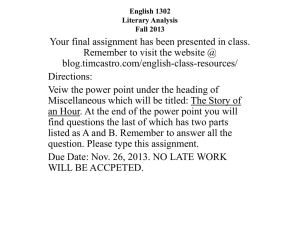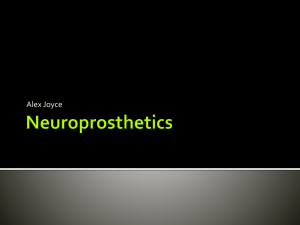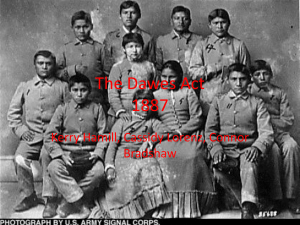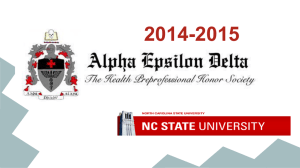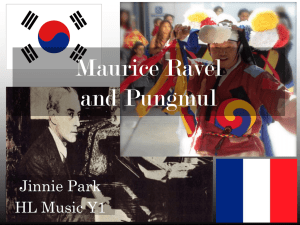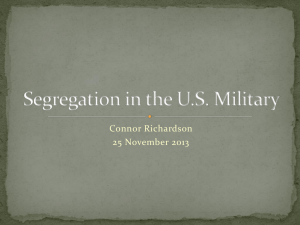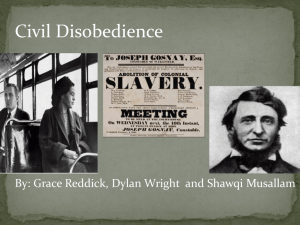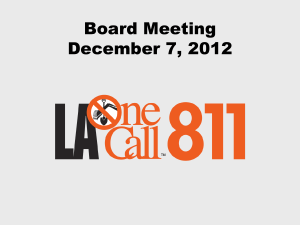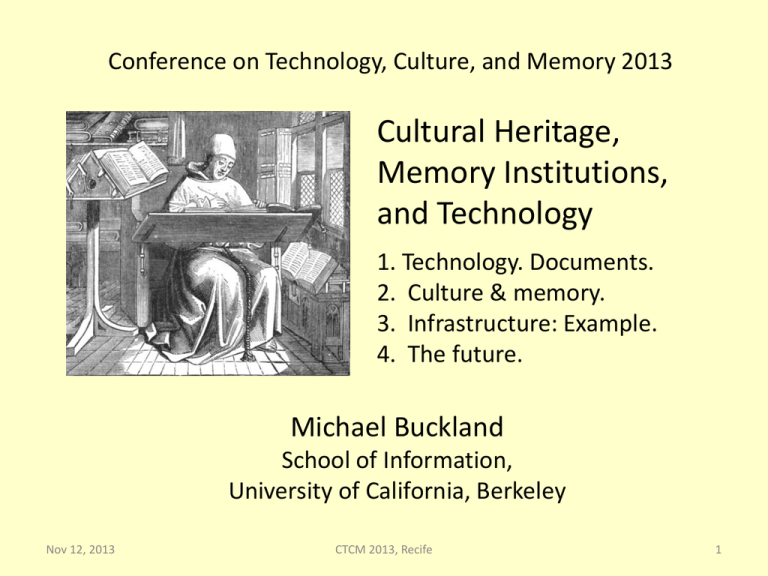
Conference on Technology, Culture, and Memory 2013
Cultural Heritage,
Memory Institutions,
and Technology
1. Technology. Documents.
2. Culture & memory.
3. Infrastructure: Example.
4. The future.
Michael Buckland
School of Information,
University of California, Berkeley
Nov 12, 2013
CTCM 2013, Recife
1
Technology and rise of the “Information society”
No. All societies are information societies!
Prehistoric communication: Gestures, language, objects, etc.
It is the rise of the “document society”.
Writing. Writing mediates speech, makes it permanent.
Effects: Continuity. Controls time. Control. Commerce.
Who can imagine life without writing?
Printing. Extreme multiplication of writing. More productive.
Consequences: Reformation; modern science; . . .
Telecommunications. Person on foot, horse, or boat. Then
semaphore, telegraph, telephone, radio, fax, television.
Reduces distance and time. Coordination. Propaganda.
Copying. Photostat, microfilm, electrostatic (Xerox).
Consequences: More writing. Image modification.
Nov 12, 2013
CTCM 2013, Recife
2
Document copying: 3 important technologies:
Photostat, microfilm, xerography.
Photostat camera: Negative
image on photographic paper.
45° mirror corrects left-right
reversal. Photostat of photostat
yields positive image. Designed by
René Graffin, editor of early Syriac
texts, Paris, 1900. Rapidly adopted
to replace copying by hand and by
typewriter. Dominant copying
technique 1910 to late 1930s.
Photostat as intermediate for microfilm, photolithography, etc.
Xerography designed to replace photostat.
Nov 12, 2013
CTCM 2013, Recife
3
Restoration of altered documents.
Ink on Benjamin Franklin’s autobiography.
Image enhancement makes legible.
Lodewyk Bendikson, 1875–1953.
Ultraviolet light shows
erased writing in
medieval vellum.
Pioneered by G. Kögel,
P. R. Kögel, & R. Kögel.
Nov 12, 2013
CTCM 2013, Recife
4
Infrared light penetrates censor’s
Ink, not the printer’s ink.
Copying is not simply making a copy,
includes analysis and visualization.
Nov 12, 2013
CTCM 2013, Recife
5
Character
_Status_
Aspects of Documents
1. Phenomenological aspect: Documents are objects
perceived as signifying something. The status of being a
“document” is not inherent but attributed (given to) an
object. Meanings are always constructed by observers.
2. Cultural codes: All forms of expression depend on some
shared understandings, language in a broad sense.
3. Media Types: Different type of expression have evolved:
Texts, images, numbers, diagrams, art …
4. Physical Media: Paper; film; analog magnetic tape; bits;….
Any document has cultural (2), type (3), and physical (4)
aspects. Genres are culturally-situated combinations.
Being digital affects directly only aspect 4, but the
consequences are very extensive.
Nov 12, 2013
CTCM 2013, Recife
6
Documents, Meaning, and Cultural Contexts
Paul Otlet 1868-1944: Extract facts from texts.
Organize into hypertextual an encyclopedia
(“world brain”). Traité de documentation, 1934.
Ludwik Fleck 1896-1961: Genesis and
development of a scientific fact, 1935.
Facts as narrative simplification.
Triad: concept, individual, cultural
mindset / thinking style.
Paracelsus 1493-1541: Physician, botanist,
metallurgist in the transition from medieval
alchemy to modern science.
Nov 12, 2013
CTCM 2013, Recife
7
What is done with documents?
Documents are used by . . .
Governments to control us
Schools to direct what we learn
Religions to instill beliefs
Advertisers to make us buy
Politicians to induce consent
Entertainers to amuse us
Individuals to attract our attention
Libraries to . . . etc., etc.
Documents are everywhere in our lives.
Use of documents not only fact-finding and problem solving.
Documents influence our lives, beliefs, and culture
Nov 12, 2013
CTCM 2013, Recife
8
2. Culture, Cultural Heritage (Patrimony), Memory
Often = “High culture” (opera, fine art,…).
Academic = How we live and think. “Culture or civilization, taken in
its wide ethnographic sense, is that complex whole which includes
knowledge, belief, art, morals, law, custom and any other
capabilities and habits acquired by man as a member of society”
(Edward B. Tylor, 1871).
How we live and think (culture) is always changing.
Cultural heritage (patrimony) and collective memory important:
1. Self-identity, self-esteem, relationships with others.
2. The development of social groups.
3. Relationships among groups. Romeo and Juliet.
4. Large commercial, political, economic interests. See newspaper.
5. Used to influence individuals and institutions. Controversies.
Nov 12, 2013
CTCM 2013, Recife
9
Cultural Heritage and Memory Institutions
(i) More than books in libraries and records in archives: Artifacts
in museums, historic sites, data sets, media,...
(ii) Extends range of “bibliographic” description to more objects.
(iii) How meaning and significance are constructed. Moves
information systems from well-defined objects in formal
contexts (e.g. data retrieval systems) into socially sensitive,
politicized areas: Death, race, sex, patriotism, war.
(v) Integrates isolated areas: archives, museums, bibliography,
cultural policy, anthropology, rhetoric, education,…
(vi) Indexing has a cultural perspective:
-- Indians of North America – Civilization = Assimilation.
-- Sexual Perversion see also Homosexuality.
(vii) Multiple different groups of users.
Nov 12, 2013
CTCM 2013, Recife
10
Time, the past, history, and cultural heritage
The past has passed. You cannot go there!
“The past is a foreign country” (D. Lowenthal).
History is narrative (story): multiple,
incomplete, extreme simplification.
“No documents, no history.”
N. D. Fustel de Coulanges.
-- and, no history, no identity.n
Whose history? Whose narrative? Women’s history. Colonial
history.
History is sensitive. Textbook controversies. War memorials.
Antiquarianism. Because it is old, not because it is important.
Nostalgia, romanticism: Remembering the good, not the bad.
Historians need accessible resources for neglected people.
Nov 12, 2013
CTCM 2013, Recife
11
Memory institutions. Memory infrastructure.
Libraries are not simply information services.
Purpose is to develop their community.
Museums: Literature on politics of museums. Enola Gay.
Much more than ALM (Archives, Libraries, Museums)!
- Education: Curriculum, textbooks.
- Publishing: If not published remains invisible.
- Historic sites: Preservation, interpretation.
- Language policy: Preservation, “purity”.
- Immigration. . . .
All involve choices of values and priorities.
All more of less political, controversial.
Nov 12, 2013
CTCM 2013, Recife
12
Indexing, Metadata, Time and Culture
Naming and describing is a language activity, hence cultural.
1: Multiple cultures, multiple dialects.
Whose dialect(s)? Cancer or Neoplasm?
2: Language, being cultural, is unstable.
Unstable denotations: What it names.
Unstable connotations: Associated ideas.
Discourses and indexer go forward in time and
change, but assigned names inscribed / fixed
at a point in time, so necessarily obsolescent
in relation to future discourses.
Changes in social acceptability.
Sanford Berman. Preferences and Antipathies. 1971.
M. Buckland. Obsolescence in subject description. Journal of Documentation
68 (2011):154-161
Nov 12, 2013
CTCM 2013, Recife
13
3. Infrastructure example: Editors’ research.
Project by
Michael Buckland
Barry Pateman
University of California, Berkeley.
Patrick Golden
Ryan Shaw
Univ. of North Carolina, Chapel Hill
Project: ecai.org/mellon2010
Web site of editors’ research notes: editorsnotes.org
Description: metadata.berkeley.edu/digdocbuckland.pdf
Nov 12, 2013
CTCM 2013, Recife
14
Annotated editions of historical texts
Berkeley: Papers of
Emma Goldman,
1869-1940,
Anarchist.
New York: Papers of
Margaret Sanger,
1879-1966,
Birth control activist.
Nov 12, 2013
CTCM 2013, Recife
15
Problems of Documentary Editions
Requires specialized expertise for many years.
Funding is difficult.
Limitations of the printed edition: Cost. Limit on number of
pages, so editors’ explanations reduced. Bought by few libraries.
Not widely available.
Much of the editors’ research not included because inconclusive
or not relevant to the publication.
Relatively isolated work.
Research and unpublished notes lost.
The return on investment far less that it could be.
Nov 12, 2013
CTCM 2013, Recife
16
How editors start research
Patrick—
Lenin:
Had any of his family members
beside his brother, been
imprisoned?
What was the book he had written
on ‘political economy’ that was used
in Russsian Universities?
New York (Evening?) Post,
September 1918 editorial on IWW
verdict for the huge IWW trial in
Chicago.
Nov 12, 2013
CTCM 2013, Recife
17
How editors use research
Sources consulted, notes taken based on findings.
Notes stored in a Word documents? Yellow notebook? Email?
Negative conclusion reached to question, but no one will ever
know.
Nov 12, 2013
CTCM 2013, Recife
18
A Collaborative Project
How might the Web be used to help?
“Editorial Practices and the Web” – started summer 2010.
Focus on evolving editorial work practices more than on
technology.
Notes on
Web?
Nov 12, 2013
CTCM 2013, Recife
19
Participants
Emma Goldman Papers, Berkeley. Feminist, anarchist, 1869-1940.
Margaret Sanger Papers, New York University, Feminist and birth
control advocate, 1879-1966.
Elizabeth Cady Stanton and Susan B. Anthony Papers, Rutgers
University: 19th century reformers, votes for women.
Labadie Collection, University of Michigan Library: Collection of
Radical literature. Why a library collection?
California State Archives. Archivists’ notes?
Led by the Electronic Cultural Atlas Initiative,
School of Information, University of California, Berkeley.
We thank the A. W. Mellon Foundation and of the Coleman Fung
Foundation for support and the project collaborators.
Nov 12, 2013
CTCM 2013, Recife
20
Phase 1 -- 2010-2012
Promote digital notes.
Create shared website for research notes: editorsnotes.org
Editors’ working notes openly available August 2012.
Library special collection curators’ notes also.
Phase 2 -- 2013 - 2015
Horizontal interoperability with archivists’ working notes.
Projects end. Scholarship continues. “Hibernating archive.”
Archiving of editors’ research notes when project ends.
Work practices preprocess for archival deposit.
Predispose for later continued scholarship.
Introduce digital humanities tools: Map displays,
Chronologies, time-lines. Biographical networks.
Nov 12, 2013
CTCM 2013, Recife
21
A Digital Remedy
Save as .html ! Make working notes available soon on a
webpage as well as published edition. Immediately available.
Indexed by Google, etc.
Ideas
Notes in
memory or
handwritten
Notes keyed or
scanned
Working notes
Notes
Notes, clippings,
images. in folders,
boxes,
Brief notes in
published volume
Files in digital
repositories
Published
Detailed notes
rapidly web
accessible
Published on the Web
More a change in work practice than a technical challenge.
Nov 12, 2013
CTCM 2013, Recife
22
Topic: Bisbee Deportations – Article-style note
Nov 12, 2013
CTCM 2013, Recife
23
Chronology of Emma Goldman’s lectures: Text to database to
visualization. http://metadata.berkeley.edu/emma/
Nov 12, 2013
CTCM 2013, Recife
24
4: Future : Of technology
FROM
Writing, the recording of speech
Printing, the multiplication of text
Telecommunications, doc. transport
Document copying
TOWARDS
Recording everything.
Representation of anything.
Simultaneous interaction.
Analysis of resources.
The change in underlying technology enables new genres.
Environment of different genres in a new tapestry.
Oral society.
Literate society (= Oral & literate)
Document society (= Oral, literate, and use of records we never
see, cannot read, but shape our lives).
Nov 12, 2013
CTCM 2013, Recife
25
Future : Of memory techniques
To use an old data set requires:
1. Discovery: Does a suitable document or data set exist?
2. Location: Where is a copy?
3. Permission: May I use it? Legal constraints?
4. Usable? Too deteriorated and/or obsolete to use?
5. Interoperability: Standardized enough to be usable?
6. Description: It is clear enough what it represents?
7. Trust: Origin, lineage, version, and acceptable error rate?
These differ. Require different remedies. Some more feasible
and/or more affordable than others.
All need to be resolved for satisfactory document use.
Modernized bibliography / documentation!
Nov 12, 2013
CTCM 2013, Recife
26
Technology, Culture and Memory
Archives, libraries, museums are
engaged in cultural agendas
through the documentation of
documents of every kind.
The effects of time and culture
require an active memory.
Memory requires preservation and
interpretation.
Culture is difficult for technology.
And now an excellent conference program!
Nov 12, 2013
CTCM 2013, Recife
27

